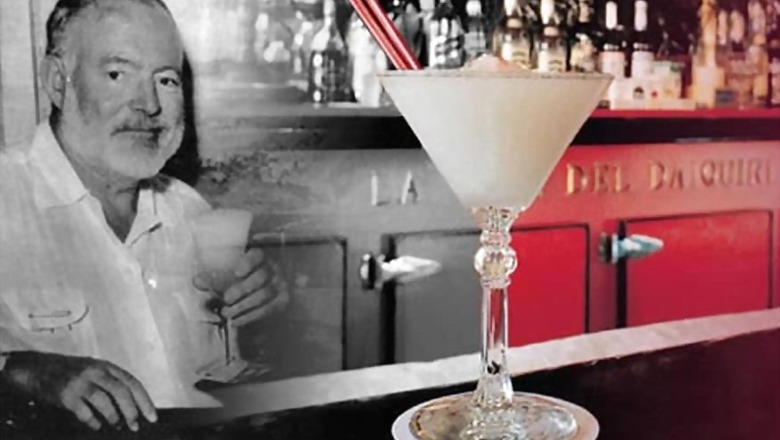
views
 Cuba, 19th Century. Fortified with bottles of Canchanchara strapped to their saddles, the mambises (Cuban guerrilla soldiers) led by Antonio Maceo, were a strong force to be reckoned with.
Cuba, 19th Century. Fortified with bottles of Canchanchara strapped to their saddles, the mambises (Cuban guerrilla soldiers) led by Antonio Maceo, were a strong force to be reckoned with.
Canchanchara, made of rum, lime juice and ‘honey’ (Cuban molasses) was not only a thirst quencher, but it was also an excellent pain killer for the guerrillas fighting against the Spanish for their independence.
Ask the 63-year-old American General William Shafter who was choking the Spanish forces from the sea. The first thing he demanded after landing on the docks of Daiquiri bay in Cuba, with 17,000 troops, was a taste of Cuban rebellion.
He wiped his lips and declared: “The only missing ingredient is ice!”
No! There were more.
Canchanchara was a killer cocktail made to buoy up the flailing spirits of rebellion. But the drink was yet to reach the pinnacle of perfection. What it needed now was a little more punch. A few more tweaks. And perhaps a few more ingredients which would help it take over the world as one of Cuba’s finest exports. However, it had to wait.
But for how long?
It had to wait until the historic day a bartender in Havana would see a great writer walking into his bar and challenging him to make a drink for him that could not hurt his diabetes. With all the sugar in Canchanchara, that would definitely be a tall order.
Meanwhile, FD Pagliuchi, war correspondent of Harper’s monthly and commander in the Liberating Army of Cuba reported to his newspaper how he was treated with a curious cocktail by a mining engineer Jennings S Cox Jr when he visited him deep in his mine in Daiquiri (14 miles east of Santiago de Cuba).
“Hey, what the heck is this?”
Cox was told that the drink was a collage of Bacardi, lemon, sugar and ice. That was one step of mutation forward from that old drink (Canchanchara) which boosted the spirits of Cuban revolutionary army fighting the Spanish.
It tasted awesome.
When Pagliuchi asked Cox the name of this curious concoction, the engineer modestly replied: it was er…ehm…Rum Sour. He had in mind, the popular Whisky Sour which was made in the same fashion, with the same ingredients except for the whisky.
C’mon! “This name is very long. Why not call it Daiquiri?”
That got stuck.
Daiquiri is the name of the place. The drink found in its mines must be carrying the spirit of the place, Pagliuchi reasoned. Demands for the drink were steadily building up in various bars in Havana.
One particular bar, La Floridita in 1918 in Havana was recently taken over by Constantino Ribalaigua Vert. Pretty soon the versatile Constantino spun out six different versions of Daiquiri including the famous Floridita Daiquiri.
But the best was yet to be.
One day the legendary writer, Ernest Hemingway, checked into room 511 at the Hotel Ambos Mundos in Havana, a little away from La Floridita. He had already gone through the horrors of Spanish civil war; he must now settle down in a peaceful town to complete his novel, ‘For Whom the Bell Tolls.’
One morning he took a long walk, dropped into La Floridita and asked Constantine whether he could have Daiquiri.
Constantine smiled. But the writer had one condition. Despite the assurances given by physicians he knew he had diabetes. So Daiquiri, which was cooked up with Rum, sugar and other ingredients, should not worsen his condition.
Constantine’s smile vanished. He thought hard for a second. Then he took out a glass and poured a double dose of Cuban Rum into it instead of one and threw in all the other ingredients except sugar.
Daiquiri without sugar! It was blasphemy!
Hemingway took his first sip of the newly-born drink handed over to him, ran it in his mouth, swallowed it and finally nodded his head, with half a smile. Yeah. He was pleased with the liquid. Since then every morning, Hemingway turned up at La Floridita in bermudas, short sleeved shirts and espadrilles, settled down on the same bar-stool and sipped a couple of drinks, watching his characters pass by along the street. In the evening the writer would come back once again to take a dozen more before he ambled back to the hotel merrily.
Even after he moved to his home, Hemingway never failed to drop by, as the drink had now become his muse. Sometimes he took it home in a thermos bottle calling the nourishment, his viaticum (provisions for the journey).
In his posthumously published novel, ‘Islands in the Stream’ he sings:
“He was drinking another frozen Daiquiri with no sugar in it and as he lifted it, heavy and the glass frost-rimmed, he looked at the clear part bellowed the frappe-ed top and it reminded him of the sea. The frappe-ed part of the drink was like the wake of a ship and the clear part was the way the water looked when the bow cut when you were in shallow water over marl bottom. That was almost the exact colour.”
Later Constantine perfected the expression by squirting a little grape juice and Maraschino liqueur to the drink and immortalised his invention by calling it Papa Doble alias the Hemingway Special.
(Manu Remakant is a freelance writer who also runs a video blog - A Cup of Kavitha - introducing world poetry to Malayalees. Views expressed here are personal)

















Comments
0 comment